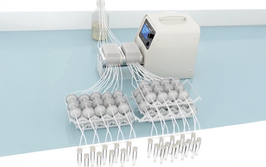Thirty Years of Chromatography Research
Pat Sandra founded the Research Institute for Chromatography back in 1986, and it has acted as an outlet for his passion for separation science ever since. Here, Pat reflects on three decades of change, challenges and success – and offers a glimpse of our field’s future.
I grew up in a region of Flanders, Belgium, known as the “Texas of Flanders” because of its entrepreneurship and bustling small family businesses. At the end of 1985, I had some tough discussions about the research program in separation sciences within our department at Ghent University. My proposals were not taken seriously. Based on my ‘innate entrepreneurship’ and the fact that industrial collaboration was not really accepted in an academic environment at that time, I decided to quit the university on February 1, 1986. And I had a plan.
In the beginning, the structure of the Research Institute for Chromatography (RIC) replicated Rudolf Kaiser’s Institute for Chromatography in Bad Dürkheim, Germany. For the most part, we survived on teaching courses and on sponsorships from Carlo Erba, Italy, and later from Hewlett-Packard (now Agilent Technologies). In 1986, we began collaborating closely with a local industrial laboratory named Servaco – and moved our instrumentation from our garage to their facilities. At the same time, Frank David, my first PhD student, joined RIC.
When my mentor and PhD promotor retired from Ghent University, I was invited by the Dean of the Faculty of Science to restart my activities at the university and also to lead the separation sciences group. I only accepted a part-time position. One of the advantages of being back in the academic world was that we could recruit several coworkers from my group of PhD students, which guaranteed a very smooth integration in the RIC activities. I am delighted to say that all of them are still with us. Starting RIC France was another adventure, and credit should be given to our first collaborator, Pascal Hoogenbosch, for successfully integrating the company’s philosophy in our French division.
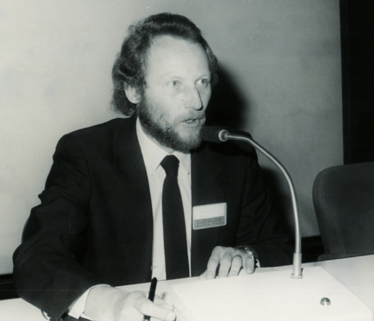
At Riva - the forum on microcolumn separations, 1983.

Teaching a course in Mumbai, 2014.
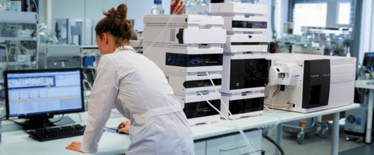
State-of-the-art instrumentation, RIC, 2016.
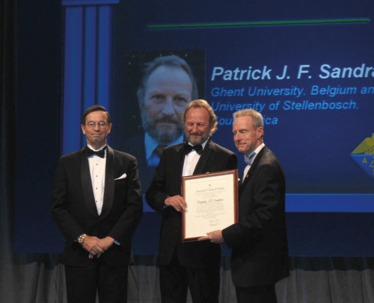
Accepting the American Chemical Society Chromatography Award 2005, San Diego, USA.
I’m proud of our achievements. We’ve been able to establish an institute with high-quality, state-of-the-art instrumentation and a staff of 35 well-trained and productive co-workers active in Belgium and France. Above all, I am proud that our customers are highly satisfied with our work and what we offer. I suspect part of our success stems from the fact that we add value in terms of both quality and speed; we do what we do relatively fast (and in direct contact with the customers) – but we can also dig very deep into the details. Our customers come to us because of our strong history – and because they know we are close to the science.
A family business
My wife, Martina, has a chemical–technical education, and was involved in RIC from the beginning, operating chromatographic instrumentation in our garage. She also took care of the admin – something I always hated. My son, Tom, has a chemical engineering degree, and joined the company in the late nineties. He worked with all instrumentation, with the main task of developing and validating methods – and drafting standard operation procedures. With the fast growth of RIC at the beginning of the century, he became increasingly involved in managing the Institute. Tom’s input into the growth of RIC (including RIC France) has been of paramount importance – the rest of us were often ‘too scientific’ and academic!
At around the same time, my other son, Koen, obtained his PhD in biochemistry and started to work in a spin-off company from Ghent University (Pronota), where his role was to build a proteomics platform for discovery and verification of biomarkers in biological fluids. In 2008, when the platform was finished and in full operation, Koen joined RIC and introduced life science activities (the –omics) and biopharmaceutical analysis. Today, Koen is Scientific Director at RIC and R&D Director at a recently founded company called anaRIC biologics – a joint venture with Anacura, a company with 15 years’ excellence in GMP.
To make the family story complete, the wives of Tom and Koen are also employed at RIC.
At the end of 2011, the management of RIC Belgium and RIC France was officially transferred to Tom and Koen. I’m still spending several hours a day at RIC, discussing current projects and difficult analytical problems with co-workers. And I’m also active in coordinating the scientific outcome of RIC (publications, application notes, and so on). At the new company, anaRIC biologics, I’m simply a scientific advisor – without any administrative tasks at all. Thank goodness.
The analytical chemist who saved Belgium
There have been several key moments throughout RIC’s history, but the most important has probably got to be the dioxin crisis. Everybody, including the government, was convinced dioxins were the problem. At that time, only two or three laboratories in Belgium could do dioxin analysis – but thousands and thousands of samples had to be analyzed. (We estimate that, before the crisis was over, more than 50,000 food samples had been analyzed.)
I immediately came to the conclusion that it was impossible for a small country like Belgium to analyze all food samples for dioxins and, based on intuition, I postulated that precursors of the dioxins, namely polychlorobiphenyls (PCBs), should be present in our food and at much higher concentrations. We took a very high risk (both from a scientific and a business point of view) by stating on the national TV news that the analytical focus should not be on the dioxins but on the analysis of PCBs. This is much simpler and much cheaper.
The Belgian authorities did not agree with us at first, but the European Community accepted our proposal, and the postulation was scientifically verified, first by us and then by other laboratories. In fact, addition of used transformer oil (PCBs!) to animal feed was the cause of the polluted food. At the same time, we described a method to analyze at least 100 samples per day, per technician, per instrument, including sample preparation. Ultimately, RIC received an accreditation in a couple of days and analyzed about 7,500 samples for the government.
The whole incident gained us international recognition. RIC was continuously in the newspapers and TV news. We were already well known – but that really established the ‘brand’.
Career... so far
- Founder and director of RIC Belgium and RIC France
- Professor at Ghent University
- Director of the Pfizer Analytical Research Centre at UGhent
- Professor at the Stellenbosch University, South Africa
- Visiting Professor at the Technical University of Eindhoven, The Netherlands
- Chairman (1983-2012) of the International Symposium on Capillary Chromatography
- Organizer of 22 International Symposia
- Co-founder of anaRIC biologics
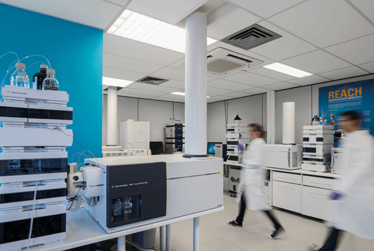
Highly productive coworkers at RIC, 2016.

Accepting Doctor honoris causa in Pharmacy from the University of Turin, Italy, 2004.
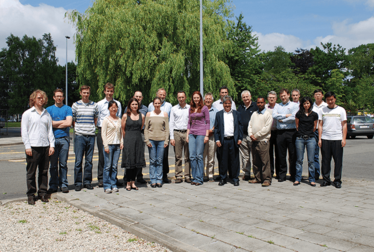
Colleagues and coworkers of the Pfizer Analytical Research Centre, UGhent, 2008.
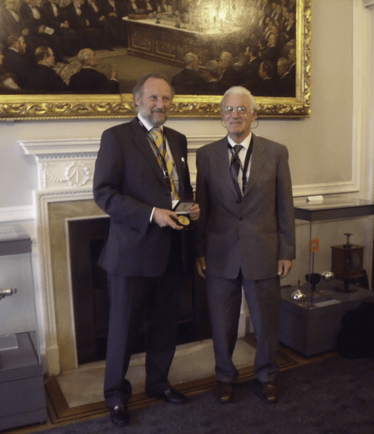
Receiving the John Knox Award for Innovative, Influential Work in the Area of Separation Science, Royal Institute, London, UK, 2009.
The RIC timeline
- 1983 Pre-RIC: from an academic environment to the garage – the “Chromalab” period.
- 1986 Founding RIC: from the garage to an industrial park – the “Servaco” period.
- 1991 Moved to Kennedypark 20, Kortrijk (500 m2)
- 1992 IOPMS foundation - ISCC
- 1995 The “Schumacher” case
- 1999 The Belgian dioxin crisis / ‘Twister’ (stir bar sorptive extraction, SBSE) developed
- 2001 RIC France established / RIC becomes exclusive Belgian and French distributor of Gerstel GmbH and Value Added Reseller (VAR) of Agilent Technologies
- 2006 Move to Kennedypark 26, Kortrijk (1,000 m2)
- 2008 Start-up of life science activities, focusing on –omics (Metablys) and biopharmaceuticals
- 2016 Founding anaRIC biologics, offering non-GMP and GMP services for biopharmaceuticals / Belgian and French distributor of Antec instrumentation
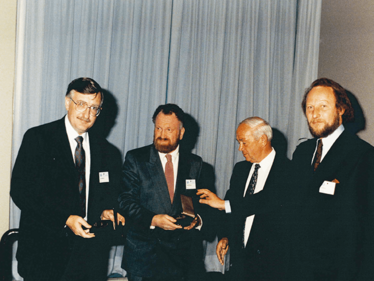
Golay Award winners Ray Dandeneau and Ernie Zerenner in Riva, 1989.
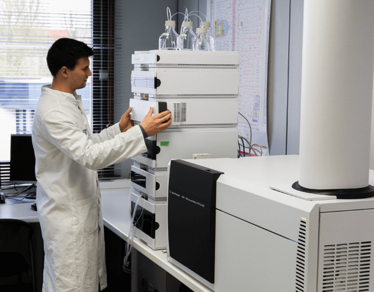
RIC researcher, 2016.
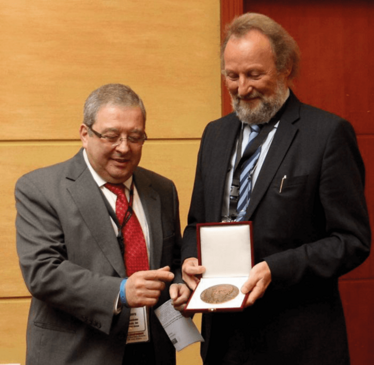
A coworker at RIC, 2016. Receiving the Csaba Horvath Medal, Siofok, Hungary, 2013.
Fundamental shifts
Things have certainly changed over the last 30 years. Something we observe frequently is how knowledge is decreasing, because the present generation are not being educated in the fundamentals as we were. And that is a great pity. It’s a consequence of the current situation; not enough people are trained in analytical science at universities and high schools. More and more people apply chromatography and mass spectrometry as techniques, but the number of systems that are sold to people who’ve never had an education in chromatography and spectroscopy is unbelievable. In fact, they are not at all interested in being highly specialized in chromatography – it’s purely application-oriented.
In the past, we ran a full course program in-house that included the fundamentals of gas chromatography (GC), GC combined with mass spectrometry, interpretation of mass spectra, liquid chromatography, sample preparation, and so on. The courses were mostly fully booked before 2000 but then the interest in fundamental courses decreased, while demand for on-site customized courses on specific applications, instrumentation or software increased.
Regardless, the present main focus on applications means that if you have a problem, you don’t always know how to solve it. For us, chromatography has always been at the center; for many scientists today it is simply a tool – and that’s a big difference. The solid fact remains that the better you know the fundamentals, the better you can apply the technique.
I think the only way to correct our trajectory is to re-introduce fundamental basic courses, covering the consequences and the theory – and how to apply techniques. We need to take great care in what we learn fundamentally; for example, interpretation of mass spectra, method development, and even the many different LC columns available. Take the latter example – there are hundreds of similar columns for reversed phase liquid chromatography. What do you select if you’re a newcomer or just an application guy in your lab, if you don’t know anything about the fundamentals of the technique? People rely on commercial leaflets – on what they’re being told at the conferences or, later on, perhaps what’s in The Analytical Scientist or other magazines. Most people using chromatography or mass spectrometry today don’t look in detail at the literature, which is, admittedly, nearly impossible as there are so many (too many) publications. To cope, you have to select papers that are closely linked to your own field, but that doesn’t give you the broad ‘helicopter’ view that we had in the past.
Our customers are very well aware of the possibilities and also of their limitations, and that’s the reason why we can continue to be successful. To be honest, if our customers had the same level of knowledge and know-how as us, then we would have no reason to exist. And I guess, in a way, my call for more – and better – training in fundamentals could actually be bad for business, but I’m not overly concerned...
30 Years of Moving Forward
From small to large
From 1986–2008, the activities of RIC were mainly related to small molecule analysis (<1,000 Daltons). From 2008, 50 percent of the activities shifted to analysis of bio-macromolecules, such as biopharmaceuticals (e.150,000 Daltons).
From negative to positive
In the early days of RIC, most analytical work was related to what we call internally “negative analytical work”, for example, pesticides and allergens in food, contaminated water, polyaromatic hydrocarbons in air. Over the years, the focus shifted to small and large pharmaceuticals, nutrients and nutriceuticals, and cosmetics; internally called “positive analytical work.”
From targeted to non-targeted
In the beginning, which targets (specific molecules: pesticides, drugs, vitamins) were in a given sample was the main analytical request. With the development of state-of-the-art instrumentation, the question shifted to ascertaining the presence of all molecules (non-targeted) in the sample (for example, metabolomics – all molecules in urine, in lung tissue, and so on).
From simple to complex instrumentation
When RIC was founded, instrumentation was relatively simple. Today, we have complicated systems integrating sample preparation, separation, identification, quantification, data handling, chemometrics or statistics.
Old science, old technology, old sample preparation... Let’s not get old
Quality of analytical data depends on the quality of the sampling procedure and the sample preparation – basically, the better your sample prep, the better your data. In recent years, we have made important progress in sample preparation and its automation, but introduction of these achievements in labs is rather slow.
It’s just incredible what is still going on today. We still have official methods, not only in Europe but also in the US, that rely on huge quantities of sample and potentially toxic solvents – even in environmental methods, ironically. For example, one of the official methods in European countries (which I will not name) requires that you take one liter of wastewater, and extract with 100 ml dichloromethane – manually. Then you start to evaporate the dichloromethane and perform the analysis. Clearly, that’s not at all state-of-the-art. You can easily miniaturize the whole procedure – and even do in-vial extraction in an autosampler. Unfortunately, such procedures are often not accepted by regulatory authorities, who apparently prefer the old technology. Another example is the still intensively applied Soxhlet extraction, invented in 1879, for solid matrices.
Going back to the dioxin crisis, the PCB method we developed for the industry long before the crisis was extremely advanced back in 2000 – and it could be applied immediately. The method included ultrasonic extraction and matrix solid phase dispersion, a precursor of dispersive SPE in QuEChERS. Using ‘official’ methods, you can only analyze a couple of samples per day rather than hundreds. And yet, even though we proved that the method performed perfectly well, what happened at the end of the dioxin crisis? The government decided to go back to the old official method… I guess change really can be hard.
Sadly, people still do not consider that sample preparation is the most important step of any analytical procedure. Understanding the goal of the analytical method and the potential limitations of your sample preparation is essential. Let’s take some examples:
- Tributyltin in water samples at the LOD of 60 (ppq) pg/L. State-of-the-art instrumentation allows us to measure extremely low concentrations (in standard solutions) but the following remarks are often not addressed: what is the blank value in your laboratory? Does your water sample contain suspended material or sediment? How do you cope with this? How do you take a subsample? What is the purity of your derivatization agent?
- Analysis of phthalates. We always have doubts when phthalate concentrations are reported in the literature in environmental samples, biological fluids, etc. The bank values in analytical labs are very high and special precautions have to be taken. Even chromatographic instrumentation has to be decontaminated from phthalates for ppb determinations. Apparently, we are one of the few labs who report blank values! Miniaturization and automation is also the way to go here.
- Pesticides in food using the QuEChERS method in combination with GC-MS. The following details are often NOT included in publications: What is the purity of your extract? ‘Adapted’ QuEChERS – how? Different results using GC and LC? How is the sample injected in GC? What inlet and inlet liner are used? What about contamination with non-volatiles of your system? Long-term performance?
- Pharmacokinetic studies in blood and plasma samples. What about removal of proteins, lipids in high throughput analysis? What about ion suppression effects?
We all have to think carefully about – and then, crucially, invest in – good sample preparation. Sample loads are increasing, which means that automation surely must be the way forward.
All that said, I do also understand the difficulties. If you are an official organization, and you have a method that works – and if to implement a new method, you have to go through a complete new validation – very often, you’re going to prefer the old method. There is no doubt that, for example, EPA methods work. But they are often based on old technology and old science – including the sample preparation. We need to change our mentality and review long-lasting methods. Likewise, I often refuse articles submitted to me for review if the paper explores a new method of sample preparation, but uses old chromatography and detection methods in its evaluation. It makes no sense.
Academia versus business
I’m frequently asked if I prefer being a company chairman or a professor. I cannot say I prefer one over the other, but I can say that I love being able to do both. Being independent and working with industry is something I like, because I get to solve real problems – and that leads to great job satisfaction. If we can help in some way to introduce a novel biopharmaceutical onto the market, it’s extremely rewarding – even more so than a great publication in the best journal. Industry is very often about reaching dynamic, practical conclusions. Conversely, being in academia means independence and research freedom – you can make more mistakes with fewer risks in the academic environment.
The additional financial responsibility is a major difference. When you’re responsible for the well-being of around 20 families, the decisions you make must be more balanced. In the early days, my primary concern in industry was how to survive; if you work as a professor, you don’t worry about that – in one or another way, everything is paid for. Indeed, colleagues working in the academic world often have no real idea of the cost of their activities; for example, I know of university labs who charge less than 500 euros per day for using a Q-TOF-MS while easily paying over 1,500 euros per day for a service engineer to maintain that system... In academia, when you make a decision to buy instrumentation, you simply ask, “what will we buy this year?” In industry, if you decide to buy something, it has to bring in money – it’s a completely different selection process.
I’ve been happy with my career. I’ve been able to combine both the academic and business worlds, and I am not sure one would have happened without the other – I guess I am one of those people who can survive in both environments.
Top six analytical milestones
- Miniaturization and automation of sample preparation
- Multidimensional chromatography
- (2D-GC and 2D-LC)
- Smaller particles (porous and core shell) in LC
- Ultra-high pressure and high temperature LC
- High resolution mass spectrometers and MS/MS
- Data handling software and advanced chemometrics
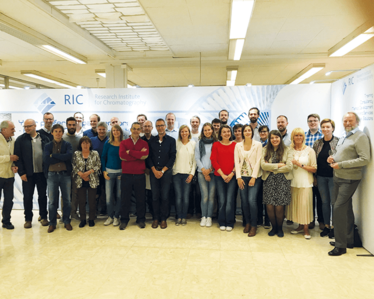
RIC Belgium and RIC France teams, 2016.
From the past to the future
When I look back, I see some key trends (see sidebar: 30 Years of Moving Forward):
- A growth from small to large
- From negative to positive
- From targeted to non-targeted analysis
- From simple to complex instrumentation
- From straightforward to complex software (data analysis time)
Over the next years, a substantial part of our energy is likely to go into biopharmaceuticals. At the beginning of this year, we started a new company together with Anacura, anaRIC biologics, because customers asked us to assist them beyond research. We are well known for our method development and for the characterization of biopharmaceuticals, and now we’re moving into good manufacturing practice (GMP) territory. It’s completely new for us and also very challenging – and significantly different to research and development, but it is also a natural progression and an important move.
Analytical chemistry is a wonderful field to work in. I believe analytical chemists are special. You solve problems, develop methods – and you need a special mentality. Whenever you visit international meetings in analytical chemistry, whatever the technique, it’s obvious that many of the attendees don’t simply ‘work’ in the field – it’s a hobby and something they genuinely hold dear. Personally, I find myself amazed every day. We published a paper on skin lipidomics in which we identified over 1,000 lipids from a very small surface layer, which is just unbelievable.
I’d like all analytical chemists to recognize the power of what we do and motivate themselves to become more enthusiastic about the fundamentals. Many people only use analytical chemistry as a tool, when they should be appreciating its real beauty.
Pat Sandra is Emeritus Professor of Organic Chemistry at Ghent University, and Founder and President of the Research Institute for Chromatography (RIC), Kortrijk, Belgium. “Through the activities of RIC, I got in touch with the real analytical needs of the industry and found we could help in providing solutions that are economically relevant. Moreover, it allowed me to keep my best PhD students around me, which resulted in high scientific output in a non-academic environment,” he says.

